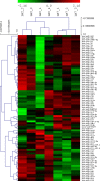MicroRNAs miR-30b, miR-30d, and miR-494 regulate human endometrial receptivity
- PMID: 22902743
- PMCID: PMC4077381
- DOI: 10.1177/1933719112453507
MicroRNAs miR-30b, miR-30d, and miR-494 regulate human endometrial receptivity
Abstract
MicroRNAs (miRNAs) act as important epigenetic posttranscriptional regulators of gene expression. We aimed to gain more understanding of the complex gene expression regulation of endometrial receptivity by analyzing miRNA signatures of fertile human endometria. We set up to analyze miRNA signatures of receptive (LH + 7, n = 4) versus prereceptive (LH + 2, n = 5) endometrium from healthy fertile women. We found hsa-miR-30b and hsa-miR-30d to be significantly upregulated, and hsa-miR-494 and hsa-miR-923 to be downregulated in receptive endometrium. Three algorithms (miRanda, PicTar, and TargetScan) were used for target gene prediction. Functional analyses of the targets using Ingenuity Pathways Analysis and The Database for Annotation, Visualization and Integrated Discovery indicated roles in transcription, cell proliferation and apoptosis, and significant involvement in several relevant pathways, such as axon guidance, Wnt/β-catenin, ERK/MAPK, transforming growth factor β (TGF-β), p53 and leukocyte extravasation. Comparison of predicted miRNA target genes and our previous messenger RNA microarray data resulted in a list of 12 genes, including CAST, CFTR, FGFR2, and LIF that could serve as a panel of genes important for endometrial receptivity. In conclusion, we suggest that a subset of miRNAs and their target genes may play important roles in endometrial receptivity.
Conflict of interest statement
Figures



References
-
- Harper MJ. The implantation window. Baillieres Clin Obstet Gynaecol. 1992;6(2):351–371. - PubMed
-
- Boivin J, Bunting L, Collins JA, Nygren KG. International estimates of infertility prevalence and treatment-seeking: potential need and demand for infertility medical care. Hum Reprod. 2007;22(6):1506–1512. - PubMed
-
- Edwards RG. Clinical approaches to increasing uterine receptivity during human implantation. Hum Reprod. 1995;10(suppl 2):60–66. - PubMed
-
- Macklon NS, Stouffer RL, Giudice LC, Fauser BC. The science behind 25 years of ovarian stimulation for in vitro fertilization. Endocr Rev. 2006;27(2):170–207. - PubMed
-
- Sha AG, Liu JL, Jiang XM, et al. Genome-wide identification of micro-ribonucleic acids associated with human endometrial receptivity in natural and stimulated cycles by deep sequencing. Fertil Steril. 2011;96(1):150–155 e155. - PubMed
Publication types
MeSH terms
Substances
LinkOut - more resources
Full Text Sources
Other Literature Sources
Molecular Biology Databases
Research Materials
Miscellaneous

